How much could you make by selling your unwanted electricals?
Most of us have a pile of unwanted gadgets and accessories gathering dust at home – chargers, headphones, kitchen gizmos we no longer use (perhaps never did).
In fact we reckon that across UK homes there’s a whopping 880 million such bits and pieces. And there is huge value locked up in this hoard – in the materials they contain, the economic costs of producing them, and the social and environmental impacts of mining and manufacturing.
This is why we’re urging everyone to sort their electricals, donate or sell them. Only as a last resort do we need to send them for recycling.
In other words, getting our lazy electricals back in the game is a win for the economy and the planet.
For you there could be a more tangible financial win. Our research shows that households in the UK could make at least £1,300 – and as much as £6,330 – from selling their unused electronics.
Let’s talk price
If you’re ready to give it a go, you’ll want to know what prices you can expect for your used gadgets.
So we investigated how much electricals are selling for, second hand. To be precise, we checked the second-hand sale prices for 14 products you’re most likely to have lying around at home.
The findings really surprised us. Whether it’s a smartphone fetching over £500, an electric toothbrush going for £105 or an electric kettle for £15 (that’s four or five coffees) you could be looking at quite a windfall.
Price guide
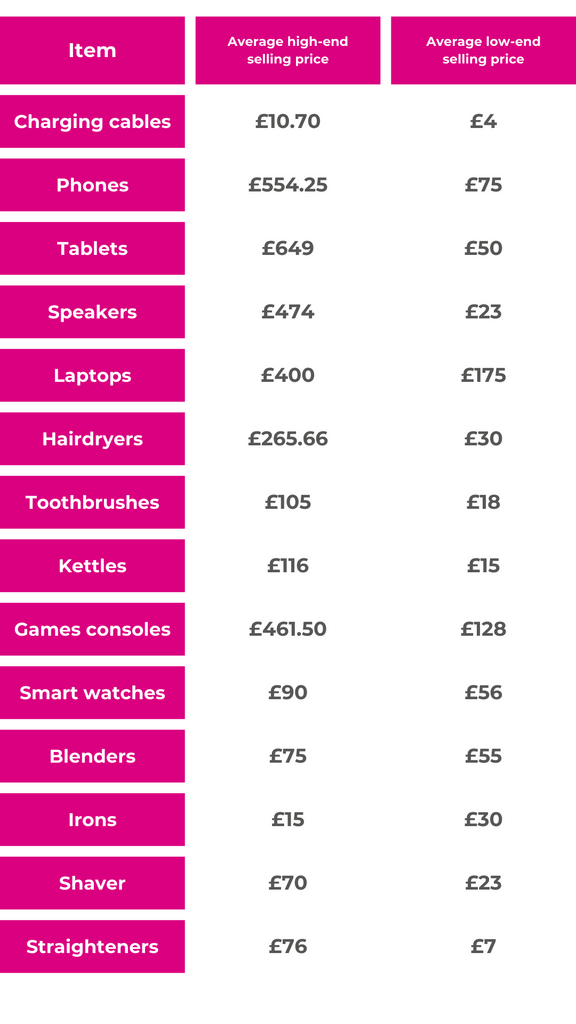
How did we come up with these prices?
We looked at the 31 products most likely to be found twiddling their electronic thumbs in UK households. Of course, many households will have more than one example of an item – two phones, three cables and so on – and our final list of 14 products reflects this. We then looked at the high and low selling prices on eBay and Gumtree for these 14 items.
So treat these prices as indicative – they’re based on a snapshot at a particular time. Lots of factors will affect how much you actually get for your product: its condition and age, where you go to find a buyer for your second hand electricals, when you publish your listing, how long you’re willing to wait, whether you go for an auction or are prepared to negotiate – and more. For advice on selling electricals online, see [link].
Now, let’s make some money.
First published 31 January 2024. We’ll update this page periodically to reflect changing prices.
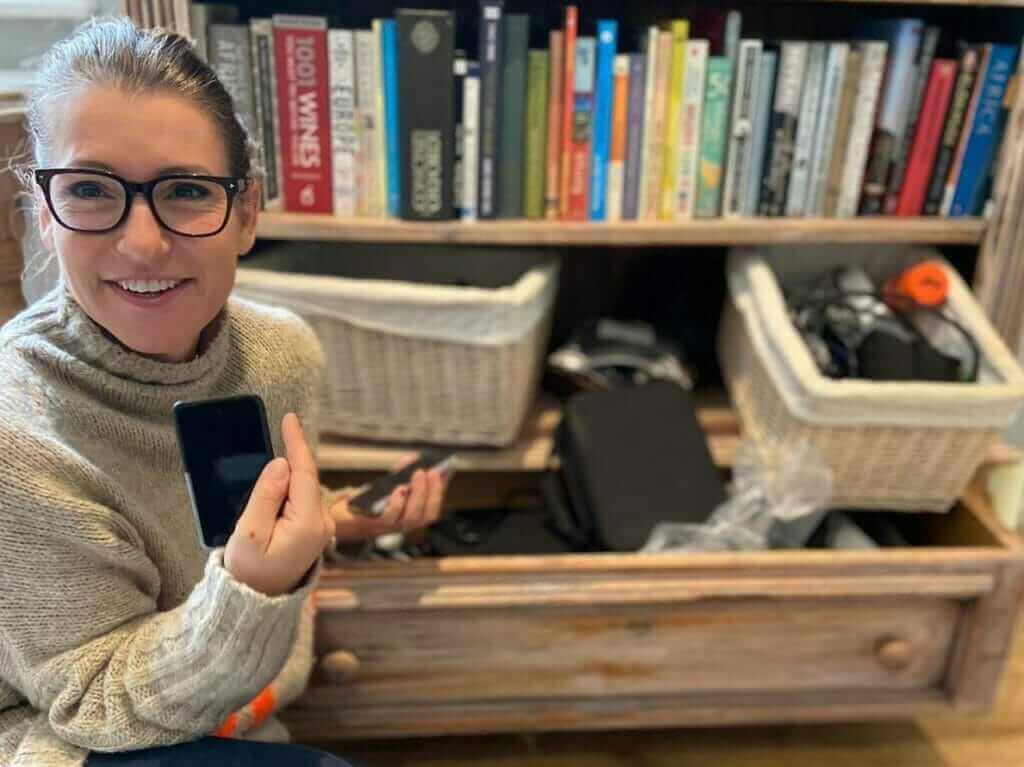
“If I open drawers and there’s stuff that hasn’t been used for ages, I might just get rid of it. ”
Karen’s battle with the clutter that a growing family accumulates will be familiar to many of us.
Sometimes her secret thrower methods don’t go down too well.
“There was an incident when we thought I’d thrown away my husband’s family videos of his childhood,” admits the marketeer and mother of two. “There was a very awkward two weeks.”
“I also took all the teddy bears out of my daughter’s bedroom. The bears went in a bin liner and into the attic.”
Everything needs sorting all the time
“I hadn’t thrown them away. Move it, hide it – if they don’t miss it then it gets thrown. All part of a process of clearing things out.”
But Karen admits: “It’s hard. Everything needs sorting the whole time. Every bottom drawer of every cupboard has items which go back years.”
“I like things to be tidy and uncluttered. And the easiest thing is to bin it quickly without anyone looking.”
Karen is not alone. More than 50% of Brits confess to binning partners’ belongings without their permission, according to research by Recycle Your Electricals.
“My husband is the complete opposite. He is a hoarder and thinks they will be useful one day,” she says.
“We’re a weird mix – me throwing stuff away, and my husband, being environmentally friendly, just keeps things. He can’t stand waste.”
“He’s got all sorts of electrical items stored – old walkie-talkies, 10 old phones including the original iPhone model – just in case!”
Breakthrough
For Karen and Jim, the breakthrough came when money changed hands.
“I eventually persuaded my husband to get rid of the phones. He sent them back and got money in return.”
“Now we work together. I want things gone, he wants to recycle, so now we do it together, and do something for the environment. We’ve met in the middle.”
“And we all have a giggle at each other’s habits.”
“He’s had a massive influence on me. It’s very good to have someone challenge you. If someone doesn’t say you can’t put batteries in the bin, you don’t learn.”
Now we recycle
“But just throwing stuff away is a lazy, easy solution, and it’s not the right solution. Recycling just requires more thought and more time. We now make sure things get taken to be recycled.”
“just throwing stuff away is a lazy, easy solution”
Reformed secret thrower she may be, but we all have our moments. Karen’s seems to be old cameras. “Cameras that are 15 years old sit there taking up space. I think we hold onto all this stuff because we love the items – they have memories, especially the cameras. And they were quite pricey once. I would throw them away but I know I shouldn’t.”
Whatever she chooses to part with next, Karen is certain of one thing. “It’s time we moved on from that throw-away feeling,” she says. “Being too busy isn’t a good enough excuse.”
Recycling electricals is quicker and easier than ever. Start by finding yourself a bag to store unwanted gadgets – the Zandra Rhodes Elecrical Tote is a great choice. Then use our postcode locator to find your nearest reuse and recycling point – there are thousands up and down the country.

Less than two years after founding her own fashion label Alex Sipa has created a dress for Nicola Roberts – a stellar journey with its roots in lace-making and recycling.
I founded my label Alexandra Sipa during lockdown in 2020 after graduating from Central Saint Martins.
I put environmental, economic and social sustainability at the heart of all my collections by upcycling and reusing discarded materials. I specifically focus on waste electrical wires in my designs.
Recycling is part of my life
Sustainability has always been important to me and part of my life – as I grew up with my uncle owning a recycling plant in Romania.
Then, while researching for a sustainability project at college, I learned that discarded electricals are one of the fastest-growing waste streams in the world.
Broken headphones
During that time my headphones broke. So instead of throwing them away, adding to this waste stream, I wanted to find a way to reuse them and put them to better use.
Taking my headphones apart, I discovered how colourful all the wires were and came up with the idea of creating a dress made solely of old electrical wires.
Inspired by lace-making
My designs are inspired by the intricate works of my grandmother’s doilies back in Romania and I adopted the technique of bobbin lace.
This is where the yarn – in my case wires – are looped and twisted together to create stunning patterns.
At first I sourced all the materials I used from a recycling centre in London. But more recently due to lockdown I’ve had to find them online through Facebook Marketplace.
“Taking apart my headphones, I discovered how colourful the wires were – and came up with the idea of creating a dress made of old electrical wires”
Spotlight on waste
Through all the garments I make I hope to address the issue around waste electricals and bring it to people’s attention more.
The partnership with the Recycle Your Electricals campaign will spread greater awareness of this – and how people can start to tackle it by reusing and recycling their old unwanted electricals.
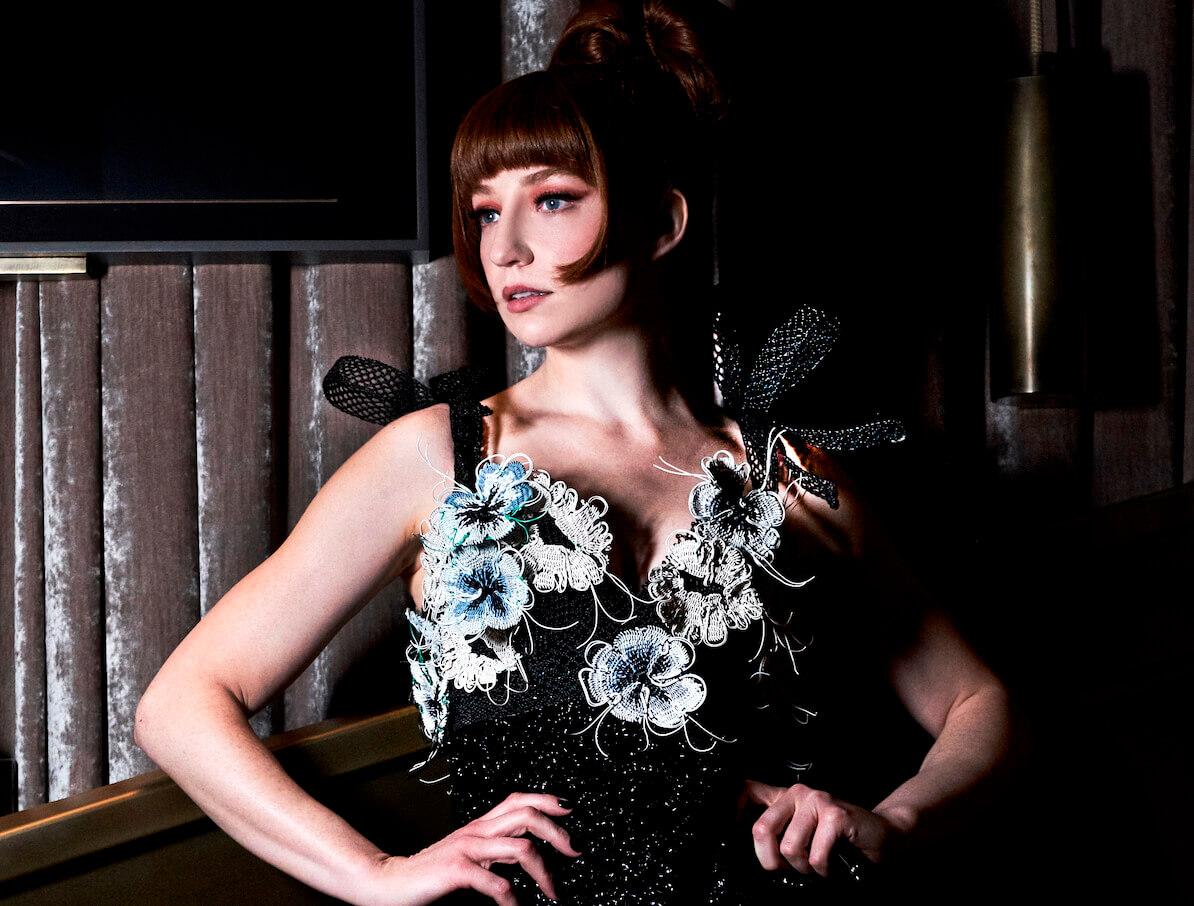
The Nicola Roberts dress
I’m very excited to have created a dress made from 210 wires for Nicola Roberts to wear on the red carpet as part of the Recycle Your Electricals campaign.
I sourced all these wires personally from recycling centres, friends and family, and even from local electricians and builders.
I’ve loved working with Nicola and have always admired her strong sense of personal style.
I hope this dress will showcase the potential of discarded materials – it’s just one of the amazing things recycled electrical wires can be turned into.


We need this campaign – and we need to know how to recycle, says celebrated entrepreneur Tillman.
Fashion guru Harold Tillman has welcomed a dress made from old household cables as a brilliant and timely way to highlight the vast potential in recycling unwanted electricals.
And he’s urged fashion designers – especially jewellers – to label their products when they are made from recycled metals, and consumers to buy jewellery made from recycled materials.
Tillman heaped praise on the dress made for former Girls Aloud star Nicola Roberts to wear at the Fashion Awards 2021 in November.
The Nicola Roberts dress was created from 315 metres of household electrical wires by the rising fashion designer Alexandra Sipa.
Tillman, one the British fashion industry’s most influential figures over the past half century, said: “I think it’s a brilliant idea – to wake people up about recycling and giving away things that could benefit the environment.”
Inspiring
The result of a collaboration between Sipa and Recycle Your Electricals, the Nicola Roberts gown is the latest initiative in the campaign to inspire the nation to recycle, reuse and donate old and unwanted electricals.
Tillman said the dress was a great way to shine a light on the benefits of reuse and recycling. “Fashion gets a lot of publicity. It can definitely create public interest and awareness in what we can do to improve things.”
Former owner of fashion brands Aquascutum and Jaeger and chair of the British Fashion Council, Harold Tillman is now Enterprise and Business Advisor for the London College of Fashion. He was awarded a CBE for services to fashion in 2010.
“I’ve got two drawers full of old plugs and things and you think Oh I might need that – but you never use them”
Perfect timing
Speaking to Recycle Your Electricals in the week of the COP26 global climate talks, Tillman said there had never been a better time to get everyone talking about how to save precious resources from going to waste.
Recycling the metals in old electricals eases pressure to mine raw materials, reducing climate-changing emissions and damage to landscapes.
Small old electricals are the world’s fastest growing waste stream: an estimated 140 million unused electrical cables are gathering dust in UK homes alone.
“You couldn’t pick a better time, with the COP going on,” said Tillman, welcoming “everything that can be done to create intrigue and interest – it will definitely open their eyes”.
Tillman expected the campaign to strike a chord with the public. “As I’m talking to you I’ve got two drawers full of old plugs and things, and you think Oh I might need that – but you never use them. So you’ve got me on board.”

Fashion’s footprint
Tillman’s commitment to sustainability goes back to his earliest days in clothing manufacturing, when he sought to guarantee decent working conditions for his employees. “It’s just ingrained in me,” he says.
As chair of the Ethical Fashion Forum the entrepreneur has also led efforts to put the fashion industry on a more sustainable footing.
“Fashion and textiles are the second largest polluter – next to oil and plastics, I suppose,” he said.
“There is progress. There is a lot more to do but undoubtedly there is interest and awareness among large and small clothing retailers, manufacturers and fashion designers in producing sustainably.”
Jewellery from recycled metals
A short hop from clothes fashion, the jewellery industry has long used recycled materials, Tillman said.
“It’s a given. They’ve always recycled. Someone would break up a diamond bracelet that has been sold and remake it into something else that can be sold. The gold can be melted down and restyled. So that’s not anything new.”
One area where the fashion industry in general could make progress is by flying less, Tillman said.
The pandemic has taught us that “people don’t need to be continually travelling around the world to run their business”.
“At one time I was going to Hong Kong once a month. But today I wouldn’t need to. A lot of this can be done remotely. So that’s a fuel saving.”
Consumer influence
While emphasising the responsibility of the industry, Tillman said the buying public also has a role to play. While we might not all be wearing Nicola Roberts-style electro-dresses any time soon, we can make other consumer choices – like buying jewellery from recycled metals.
Tillman called on jewellery designers and brands to be more assertive about their use of recycled metals. “The public could be told more clearly – and these things do make a difference.”
“I think the public should start to look at what they’ve got. Do they need another one? Do they know they’ve got it? And resale is becoming really predominant, which is a very good idea because the product is going onwards to another user.”
‘We need to know how to recycle electricals’
Parallels between the fashion and consumer tech market are obvious.
Anything with a plug, battery or cable can be recycled – and recycling can start with a repair, passing on or selling something.
Or it can mean ensuring that the valuable materials like gold, silver and copper in electricals are salvaged and remade into something useful – or beautiful.
“It all comes back to the same thing: how we can produce materials without smoke coming out of chimneys”, said Tillman.
“It’s not just one voice like Greta Thunberg that needs to be talking about this.”
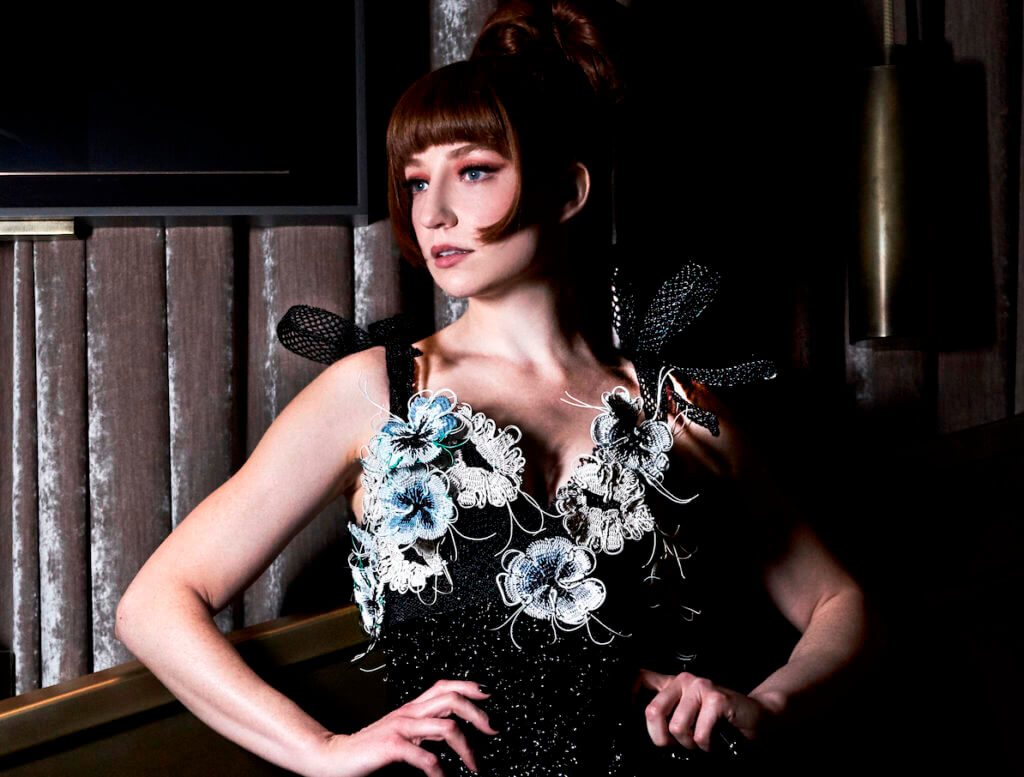
So would it make sense to make sure that all those cables and smartphones we have sitting around get recycled?
“Absolutely,” said Tillman. “I really, really think it’s brilliant. We need a campaign – and not only a campaign but we need to know how it can be recycled.”
As for the how, Recycle Your Electricals has got you covered: you can find your nearest electrical recycling point using our handy locator. The campaign to get everyone on board continues.

Pop star and fashionista Nicola Roberts says the dress made for her from recycled electrical cables demonstrates the potential and beauty of recycling.
Dazzling at the Fashion Awards 2021, Nicola wore a dress crafted by fashion designer Alexandra Sipa from 210 recycled electrical cables.
Discarded cables, along with other small, old electricals are creating the world’s fastest growing waste stream.
Nicola said: ““We all have a duty to make sustainable choices. As the consequences of our demanding and accessible way of living begin to increasingly show themselves, it’s something I feel a responsibility to do more and more. For instance, the impact of electrical waste is something few people consider.”
“Working with Alexandra Sipa and the team at Recycle Your Electricals has been an interesting and enlightening journey. My dress has been created from 210 electrical cables and I’m proud to be able to show you just what is possible when supporting sustainability with recycling and just how beautiful it can be.”

The Recycle Your Electricals campaign aims to get UK households to stop throwing away or hoarding small old electricals and instead start donating or recycling them. Electricals contain some of the most precious materials on our planet – gold, silver, copper, aluminum, and platinum.
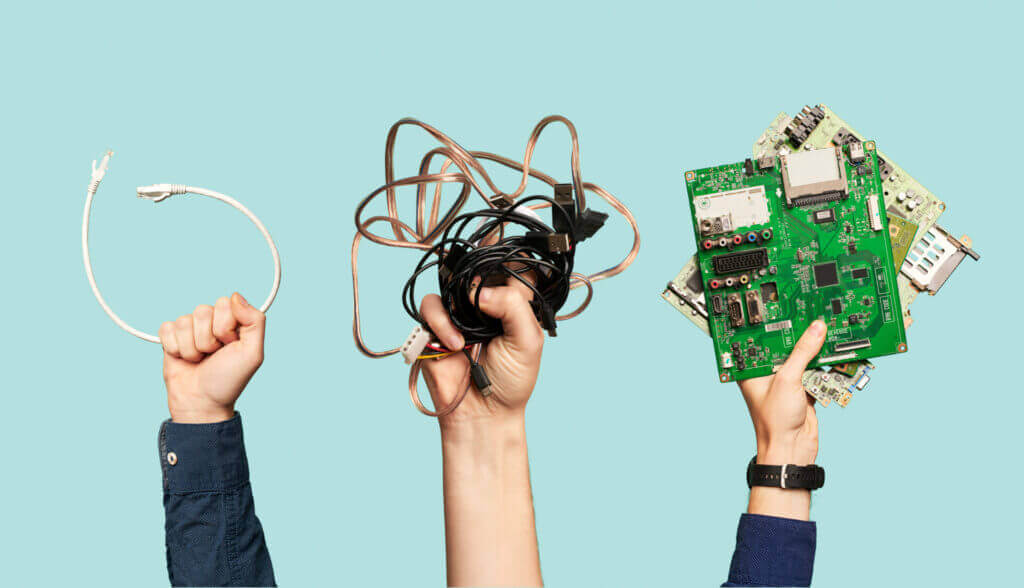
What the waste guru found lurking in the kitchen.
There’s not much Rachelle Strauss doesn’t know about waste and recycling. The author, campaigner and sustainability consultant is founder of the award-winning Zero Waste Week. Since 2008 the Zero Waste campaign has got thousands of businesses and millions of ordinary people thinking hard about the hows and whys of reducing waste and making more of the precious, finite resources this planet affords us.
But even Rachelle had to do a double-take when she learned about the sheer volume of unwanted, unused electricals hiding away in UK homes. And in her own home to boot.
“I don’t know about you, but when I root around in the kitchen ‘junk’ drawer, I’m pretty horrified by what’s in there,” she writes on her Little Green Blog.
“As well as all those ‘must-have’ utensils that have rarely seen the light of day, there are all those old handsets and gadgets. Not to mention the transformers and charging leads that don’t seem to match anything you still own.”
E-waste is a global problem
In fact, Rachelle,learned, her kitchen-drawer stash is just part of a global problem. The cables hoarded in UK homes alone could circle the planet more than five times, according to research by Recycle Your Electricals. And there’s more. Globally we generate over 50 million tonnes of electrical waste a year, equivalent to 7.3 kg for every man, woman and child on Earth.
“Scour those drawers and cupboards. Find all those old, unwanted gadgets and recycle your electricals!”
But it’s not just a numbers game. There’s a real cost to the planet and people. “The trouble is electrical waste contains valuable materials such as gold, silver, aluminum and copper,” Rachelle reflects. And mining for these precious metals has serious environmental impacts.
But her work is all about solving problems. And Rachelle’s blog delights in reporting on efforts around the world to crack the e-waste crisis – from students in the US learning how to repair electronics, to a start-up in India creating plant pots from recycled electrical waste, to a major jewellery brand planning to buy only recycled metals.
So she is happy to get behind the Give-Back January campaign and start bringing the message home – literally. “Scour those drawers and cupboards,” says Rachelle. “Find all those old, unwanted gadgets and recycle your electricals!”

Interiors expert gets behind Give-Back January.
Journalist Kate Watson-Smyth was taken aback to learn about the enormous amounts of unwanted electricals hiding away in homes across the UK. “Staggering” was her word for it when she learned from Recycle Your Electricals that some 31 million laptops, for example, are “sitting in houses doing nothing”.
Kate is an interior design consultant and co-host of the Great Indoors podcast. So she naturally sets great store by the look and feel of her home. That home has featured in Living Etc, HeartHome, The Wall Street Journal and Corriere della Sera.
“I would sum it up like this: something old, something new, something black, something gold. And always some natural wood. I like to call it Urban Glamour. You may prefer Modern Rustic.”
“I discovered the box full of old cables, an obsolete playstation box, an unused speaker. And yet more cables”
Imagine Kate’s shock, then, when she discovered rather more old stuff than she’d been expecting. An unplanned, unglamorous tangle of old electricals hidden away in this lovingly cared-for home.
She learned about Give-Back January. This is the campaign to encourage more people to donate unwanted electricals to good causes. Kate imagined she would struggle to come up with any old gear. “I was worried I didn’t have any. I routinely send old phones back to be recycled and we don’t really have anything that’s broken.”
Cable guy
“Then I decided to clear out a cupboard in my office, now being done up for the 17-year-old. There I discovered the box. The box that is full of old cables, and an obsolete playstation box and its controllers. And an unused speaker. And yet more cables.”
Learning that there are enough cables in UK homes to go round the Earth five times over, Kate said: “I think it’s possible that half of those were in my cupboard.”
Find out what Kate did next: jump across to her award-winning Mad About the House blog – then check out our tips on donating your unwanted electricals to charity.
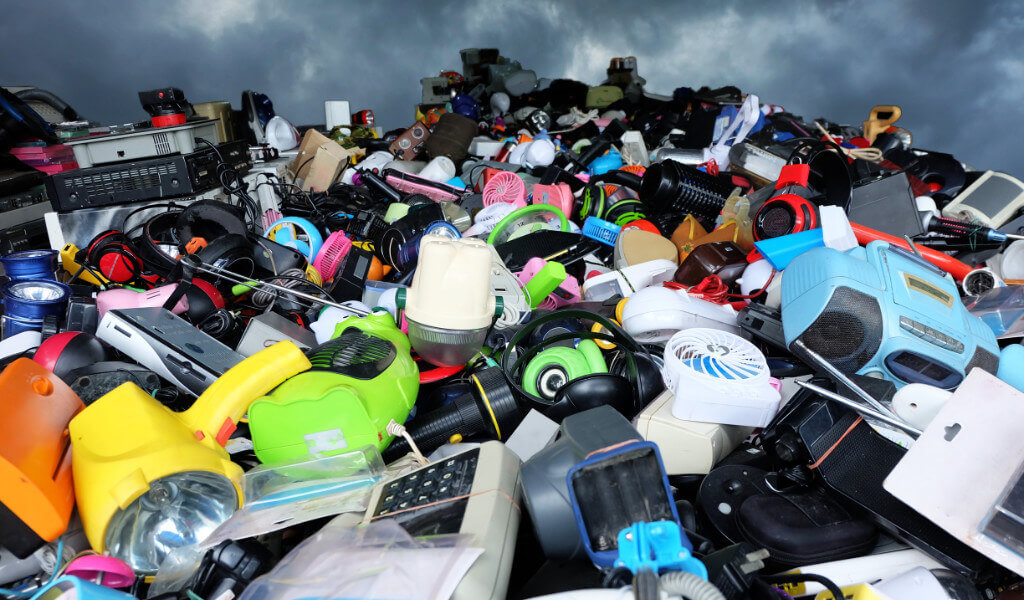
Mary is a self-confessed secret thrower.
“Our garage is a dump,” says Mary, founder of media company News Presenters. “We just throw stuff in and forget it’s there. It’s got so bad I can’t get in there.”
Intriguingly, the hoard includes a clutch of tennis bags belonging to the great Martina Navratilova – but that’s a story for another day.
Otherwise the Greenhams’ garage is typical of many a UK family household. Fish tanks, cat carriers, “endless hockey sticks”, golf clubs, DIY materials – some to be used again, some simply gathering dust.
Then there are the electricals. From the big stuff – “a fridge freezer which needs to go to the recycling centre when we can book a slot”, says Mary. To small gadgets – “six old phones, two Nintendos, one Ipod and loads of charging cables.”
“It would probably only take a couple of hours to sort through it all and take it down to the recycling centre.”
Bone of contention
The garage is, she confesses, a bone of contention with husband Jon. “I think he’s a hoarder, and he thinks I’m a messy person.”
“I could clear out all my stuff, but not his. It would probably only take a couple of hours to sort through it all and take it down to the recycling centre.”
One day Mary broke that unspoken rule, secretly throwing out Jon’s laptop case and other bits and pieces. “They were annoying me and I knew it would be quicker just to throw it away rather than having to wait to go through it all with him.”
“He was very unhappy with me at the time. He’s forgiven – but not forgotten – because he knew they had to go.”
Deal maker
Perhaps that was the breakthrough. Now Mary and Jon have done a deal – his golf clubs for her hockey sticks.
What’s more, Mary has been inspired by the Recycle Your Electricals campaign to start sorting and recycling their old electricals.
“We’ve done one clear-out, including boxes of electrical equipment – we went through what we could recycle, dump and donate.”
The future is recycling
Covid-19 lockdowns in the past year have proved to be a great spur to decluttering. This spring is no different. Material Fous polling suggests about 80% of households have been decluttering in 2021, a fifth more than the previous spring.
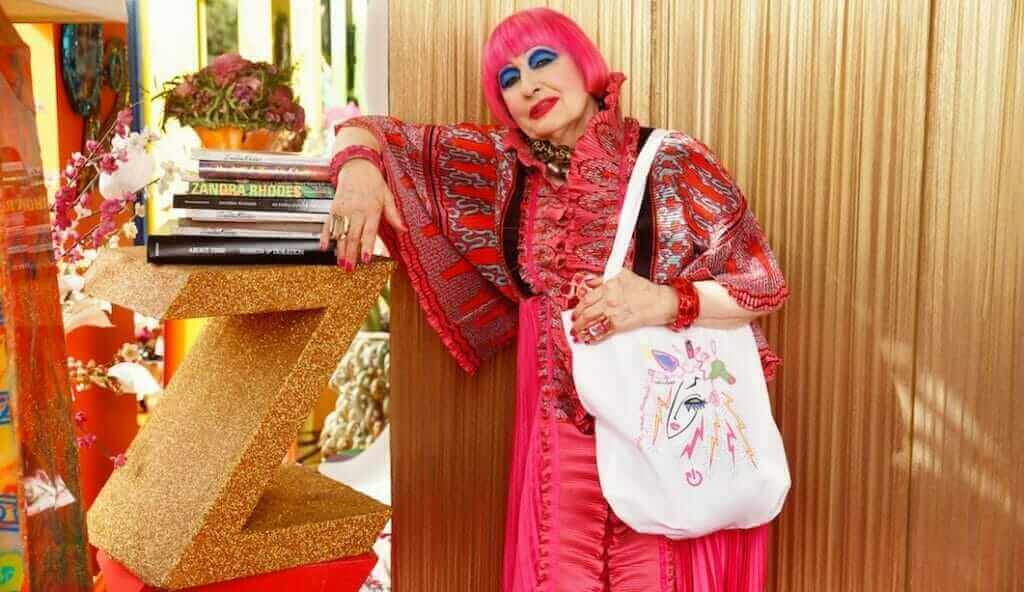
Zandra shows off the Zandra Electrical Tote,
created exclusively for the Little Spring Clean 2021 by
British fashion icon Dame Zandra Rhodes.
“Another box has built up again during lockdown. It needs to be sorted out and then taken to be recycled,” says Mary.
“Now that I’ve heard about the Recycle Your Electricals campaign I will definitely, in future, be recycling all our electricals,” she adds.
“I’m much more motivated to do this now I know how important it is to the environment to recycle electricals.”
Some things are still off limits, however. Lurking somewhere in the Greenhams’ garage are Jon’s old vinyl records. “I would not dare touch those,” says Mary.
Find your nearest recycling point using our easy postcode locator.
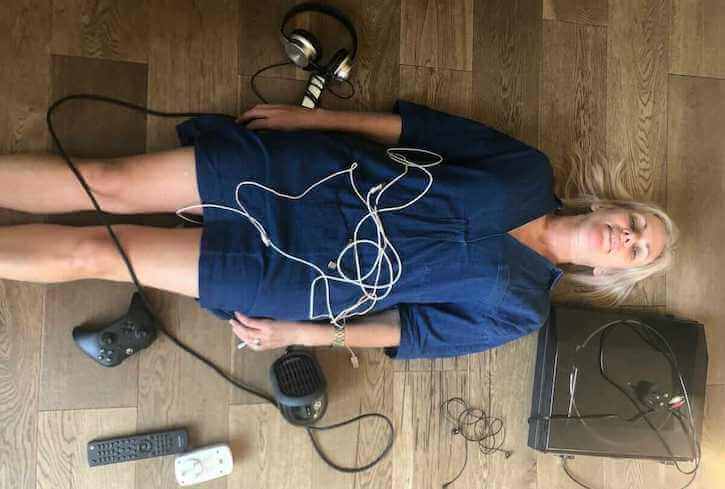
“Until now, I think a lot of people didn’t know what they could do with their old electricals.”
Kate, a communications director living in south east London, was delighted to learn from the Recycle Your Electricals campaign that plastics in old electricals can be turned to good use.
Q: Were you aware that electricals are one of the fastest-growing waste streams in the UK and the world?
Kate: I didn’t know the statistics, but I knew that it was a huge and growing problem. Now I know just how serious it is.
Q: How do you feel about the fact that 75% of electricals contain precious metals such as gold, aluminum, copper and plastic?
Kate: A few things. One is how readily we throw away precious materials, and the economic waste involved.
Two is that I don’t think this statistic is well-known or understood.
And three, that you’ve grouped plastic with precious metals – which I think is absolutely correct. Plastic is an amazing resource but we don’t value it as we should and as a result the planet is filling fast with plastic. Throwing away, rather than re-using or recycling these materials, can cause great damage to the environment and to our health.
Repair. Donate. Recycle.
Q: What do you do with your old electricals when you no longer use them?
Kate: The ones that still work well we take to the local charity shop. Those that are broken, if we’re going to use them again, we look into getting them repaired, and those we won’t use again we’ll take to the recycling place.
Q: What types of electricals do you keep in your home, and do you hold on to any particular types? If so why?
Kate: Pretty much everything, from big items like an oven and a washing machine, to hair dryers and lamps, to things like smart phones and laptops. Some we use every day and others (like the lawnmower) not so much. I reckon we’re holding on to at least unwanted 15 electrical items.
For some reason we seem to have loads of smart phone chargers and headphones in the house, even ones that don’t work. I think we keep hoping they might start working again. So far that hasn’t happened.
It’s so important that we re-use, re-purpose and recycle our electrical goods.
Q: What was the most interesting thing you found about the Recycle Your Electricals campaign?
Kate: I’m just really pleased that this campaign is running. It’s so important that we re-use, re-purpose and recycle our electrical goods. In fact, it’s really important that we reuse and recycle everything we can. But until now I think a lot of people didn’t know what they could do with these items.
So it’s great to get this message out loud and clear: don’t throw it away, recycle it.
Photo: Kate’s selfie with her unwanted electricals was inspired by award-winning photographer Gregg Segal’s Hidden Treasure series. Why not tell us your story and send your own snap of yourself and your old electricals?
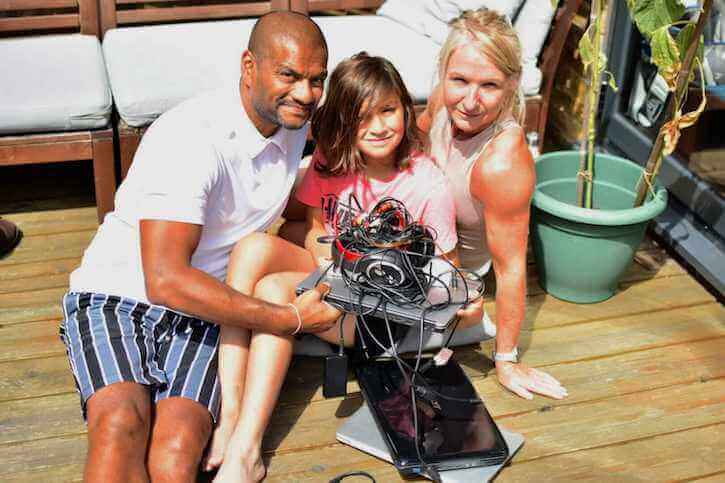
“We have so many old electricals – and we don’t know how to recycle safely.”
Media consultancy owner Sam Kumar has been recycling for a decade – as much as he can. But even this old hand at recycling admits that he was stumped by how to dispose of some unwanted electrical items – toys and smart devices among them. Until now.
“As a family we care about sustainability and current matters that have had a major impact – such as racism and Black Lives Matter,” says Sam.
The family recycles “as much as we can and as often as we can” to help the environment.
Not knowing what to do with old electricals is a blocker
So what prevents them recycling all their old electricals?
One barrier is not knowing how to recycle certain products safely and securely. Sam is not alone. Millions of us hang on to old smart devices because we’re not sure how to delete personal data on them safely.
“We have a community on social media for the residents of our street, which has been a great platform for recycling smaller electricals.”
Plus, he says “We have so many.” By the time their son was two years old their house was “overflowing” with electrical toys and games, Sam explains.
They would give away most of those items to friends and family, sell some on eBay or take them to charity shops. “But can you believe that no one wanted the robot dinosaur or the tablet computers?” he told Forbes magazine recently.
As a result, tablets were among the things that accumulated, unused, at home. That is until Sam found out about the Recycle Your Elecricals recycling locator, which pointed Sam to locations that would welcome electrical items. “I was genuinely surprised by the places that will recycle them,” he told Forbes. “We are definitely more proactive when it comes to recycling and reusing electricals now.”
And Sam’s top tips for recycling electricals? “We have a community on social media for the residents of our street, which has been a great platform for recycling smaller electricals.”







